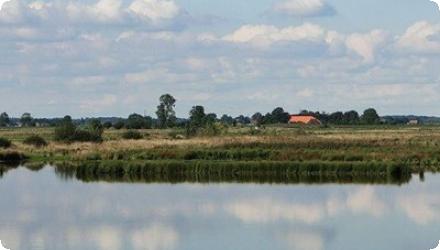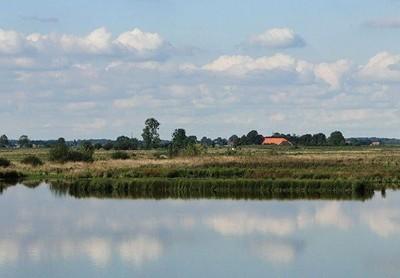Last update
2025
Summary
The Holter-Hammrich project combined several natural water retention measures: floodplain restoration, meadow and pasture rehabilitation, and reduced tillage. Located in north-west Germany within the Weser river basin (DE4000), it supports Lower Saxony's otter and wetlands protection programs and contributes to WFD goals. Since its implementation, the 240 ha flood retention polder—activated in 2011—has enhanced flood protection and become a key habitat for over 60 bird species and other wildlife, including the returning European otter. It now also serves educational and recreational purposes, with a 7 km nature trail and observation points. The project stands out for its integration of ecological, hydraulic, and public engagement goals, achieved through multi-stakeholder cooperation involving environmental agencies, water managers, local authorities, and farmers.
Position
Latitude
53.1982
Longitude
7.6115
Project
NWRM
National Id
Germany-01
Installation date
2011-05
Implementation Status
Contact
Tamer Fawzy, BEF DE
RBD code
DE4000
Transboundary
0
Photo gallery
Location of the project
The Leda-Jümme area is a flat, broad valley of the lower Ems river.
NUTS Code
DE94 - Weser-Ems
Involved Partners
| Authority type | Authority name | Role | Comments |
|---|---|---|---|
Climate zone
cool temperate moist
Temperature
9
Annual rainfall range
0 - 300 mm
Runoff range
150 - 300 mm
Slope range
0%-1%
Vegetation class
Grassland
Project scale
Micro
Project scale specification
Subarea "Leysser Hammrich" (143 ha), Habitat for grassland birds
- landuse with different requirements (extensification)
- use of controlled water level increase in winter and spring
Subarea "Altes Tief" (80 ha) diverse mosaic of shallow water zones, shrubs, reeds and wet grassland - Mostly free vegetation development (succession)
- use of ca 40 ha year-round wet areas of shallow water
- landuse with different requirements (extensification)
- use of controlled water level increase in winter and spring
Subarea "Altes Tief" (80 ha) diverse mosaic of shallow water zones, shrubs, reeds and wet grassland - Mostly free vegetation development (succession)
- use of ca 40 ha year-round wet areas of shallow water
Performance timescale
1 - 4 years
Project area
223
Area subject to Land use change or Management/Practice change (ha)
223
Size
223
Size unit
ha
Lifespan
40
Integration of demands, integrative planning, functionality
3800000
For the present area an independent concept has been developed that fitted the local requirements of nature conservation and flood protection.
natural site conditions, in particular the height variations of the area
Positive influence effectiveness
Due to the natural site conditions, in particular the height variations of the area, the Holter Hammrich serves common goals of flood protection and nature conservation.
Total cost
€ 12,600,000
Costs land acquisition
€4,000,000
Costs operational information
€ 80,000 Technical constructions
€5,500,000 Specially prepared trail for nature information and experience
€3,000,000 New Roads for farmers
€5,500,000 Specially prepared trail for nature information and experience
€3,000,000 New Roads for farmers
Information on Economic costs - income loss
Actual income loss: Lease Agreements are given out for free, due to heavy regulations for farming
Financing authorities
Type of funding
Sub-national funds
Comments
Land acquisition
Type of funding
EU-funds: Cohesion and regional development funds
Comments
The cost for a specially prepared trail with nature information were covered by European funds.
Type of funding
National funds
Comments
Other measure were financed from different sources due to the various goals. NWRM unrelated constructions of dykes and technical facilities were paid from water management sources, whereas reconstructions of roads were paid by rural development funds.
Policy context
Due to the natural site conditions, in particular the height variations of the area, the Holter Hammrich serves common goals of flood protection and nature conservation.
The closure of the last dike breaches, and the further expansion of pumping stations for drainage of the area led to new problems: After heavy rainfalls flood loads led to higher water levels, dykes were threatened to breach leading to floods at unpredictable places. More storage space was needed and finally built for excessive headwater.
Extensification or abandonment of agricultural use and high water levels in spring support an increase of characteristic breeding birds for example.
Amphibians benefit from standing water bodies.
The closure of the last dike breaches, and the further expansion of pumping stations for drainage of the area led to new problems: After heavy rainfalls flood loads led to higher water levels, dykes were threatened to breach leading to floods at unpredictable places. More storage space was needed and finally built for excessive headwater.
Extensification or abandonment of agricultural use and high water levels in spring support an increase of characteristic breeding birds for example.
Amphibians benefit from standing water bodies.
Community involvment
No
Design consultation activity
| Activity stage | Name | Key issues | Comments |
|---|
Policy target
| Target purpose |
|---|
|
Improved Biodiversity
|
Target Remarks
Flood control and flood risk mitigation
Nutrient Pollution
Biodiversity and gene pool protection in meadow areas
Habitat restoration
Nutrient Pollution
Biodiversity and gene pool protection in meadow areas
Habitat restoration
Policy pressure
| Pressure directive | Relevant pressure |
|---|---|
|
WFD identified pressure
|
Nutrient pollution
|
|
Floods Directive identified pressure
|
Natural exceedance
|
Policy impact
| Impact directive | Relevant impact |
|---|
Requirement directive
| Requirement directive | Specification |
|---|---|
|
Other EU
|
Habitat Directive: Otter protection, habitat restoration
|
Policy challenges requirements
The Lower Saxony otter protection programme and the Lower Saxony wetlands protection programme were aimed to be addressed.
Contractual arrangements
0
| Arrangement type | Responsibility | Role | Name | Comments |
|---|
Part of wider plan
1
Wider plan type
| Wider plan type | Wider plan focus | Name | Comments |
|---|---|---|---|
|
Lower Saxony otter protection programme
|
|||
|
Lower Saxony wetlands protection programme
|
Regularly
Maintenance
Maintenance schemes have not been set up. The state of Lower Saxony is contractual responsible for any maintenance required.
Unknown
N.A.
Biomass production, recreation, and information.
Information on retained water
3.8 million m3
Information on increased water storage
N.A.
Information on runoff reduction
N.A.
Water quality overall improvements
N/A info
Information on Water quality overall improvements
N.A.
Soil quality overall soil improvements
N/A info
Information on Soil quality overall soil improvements
N.A.
1
Extensification or abandonment of agricultural use and high water levels in spring support an increase of characteristic breeding birds for example. Amphibians benefit from standing water bodies.
Ecosystem impact climate regulation
No information available
Information on Ecosystem impact climate regulation
N.A.
Information on Ecosystem provisioning services
N.A.
Key lessons
A continuous and open discussion between all involved groups led to a high acceptance of the overall process. It was a key lesson of this measure that cooperation between different sectors (flood protection, nature conservation etc.) as well as different stakeholder groups (government agencies, NGO†™s) are able to cooperate in effective networks, when a consistency of goals is given.
Success factor(s)
| Success factor type | Success factor role | Comments | Order |
|---|---|---|---|
|
Communication activities
|
main factor
|
A continuous and open discussion between all involved groups led to a high acceptance of the overall process. |
2
|
|
Attitude of relevant stakeholders
|
main factor
|
Willing stakeholders and a positive public perception were the major enabling factors. |
|
|
Financing possibilities
|
main factor
|
The availability of financial resources and cooperation between all stakeholders led to a smooth implementation of all measures. |
Driver
| Driver type | Driver role | Comments | Order |
|---|---|---|---|
|
Organisation committed to it
|
main driver
|
The NLWKN is the Nature Protection Agency of Lower Saxony
|
1
|
|
Availability of subsidies
|
secondary driver
|
2
|
Flexibility adaptability
For the present area an independent concept has been developed that fitted the specific requirements of nature conservation and flood protection as well as the specific landscape. In similar settings, the technical dimension of the measure is adaptable.
Transferability
The most important precondition for a similar applications is a consistency and cooperation between different stakeholders, so that various financial instruments can be activated to achieve a common goal.
Source(s)
English

